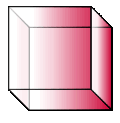|
Gases, involved in chemical reactions show simple ratios between gas volumes. This makes dealing with gaseous reactions very simple in terms of calculations. Syllabus referenceStructure 1.4.6 - Avogadro’s law states that equal volumes of all gases measured under the same conditions of temperature and pressure contain equal numbers of molecules.
Guidance Tools and links
|
Gay Lussac's law
In 1808 the Freanch chemist Gay Lussac investigating the reactions of gases came to the conclusion that when gases combine chemically they do so in volumes that have a simple ratio to one another, and to any gaseous product, provided that all gases are measured at the same temperature and pressure. This became known as Gay Lussac's law.
For example, in the reaction between hydrogen and oxygen making water:
|
hydrogen + oxygen 2H2 + O2 |
The volume of hydrogen needed for complete reaction is always double the volume of oxygen, provided the temperature and pressure of the two gases are the same.
 |
 |
 |
|
2 volumes of hydrogen
|
1 volume of oxygen
|
|
Avogadro's hypothesis
Extending Gay Lussac's work in 1811, Avogadro suggested that "equal volumes of all gases contain equal number of molecules (the gases being measured at the same temperature and pressure). This became known as Avogadro's hypothesis or Avogadro's law.
This means that in the reaction:
N2 + 3H2 ![]() 2NH3
2NH3
For a given volume of nitrogen, three times the volume of hydrogen is needed for complete reaction. The volume of nitrogen contains a certain number of molecules and there are three times as many molecules in the volume of hydrogen.
|
N2
|
+
|
3H2
|
|
2NH3
|
|
1 molecule
|
+
|
3 molecules
|
|
2 molecules
|
|
1 volume
|
+
|
3 volumes
|
|
2 volumes
|
Avogadro's hypothesis allows us to substitute the coefficients of any balanced gaseous equation for volumes of gas, for example:
|
Example: Find the volume of hydrogen required to react completely with 200 cm3 of nitrogen according to the equation: N2 + 3H2 The equation tells us that 1 volume of nitrogen reactrs completely with 3 volumes of hydrogen: Therefore volume of hydrogen = 3 x volume of nitrogen Therefore volume of hydrogen = 3 x 200 cm3 = 600 cm3 |
|
Example: Using the equation: N2 + 3H2 if 100 cm3 of nitrogen was used (this is now equivalent to 1 'volume') it would need 3 times as much hydrogen for complete reaction i.e. 3 volumes = 300 cm3. The reaction would produce 2 volumes of ammonia i.e. 2 x 100 cm3 = 200 cm3 |

